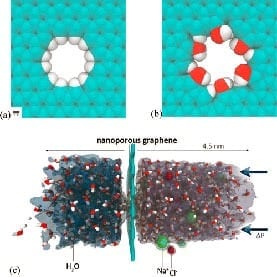
Computer simulations indicate graphene desalination membranes could vastly outperform existing reverse-osmosis systems
The earth harbors about 1.4 billion cubic kilometers of water. Unfortunately, the vast majority of that water comes from the sea and is not potable unless treated by expensive, energy-hungry desalination plants. Those problems stem largely from inefficiency in the way salt ions are separated from water molecules, and the solution, says a team of materials scientists from the Massachusetts Institute of Technology, lies in fundamentally revising that process.
The predominant desalination method today—reverse osmosis (RO)—relies on polymer-based membranes to remove salt and requires great pressure to push water through a semipermeable film.The more pressure applied, the higher the cost. The M.I.T. researchers, led by Jeffrey Grossman and David Cohen-Tanugi, propose that films made of graphene could filter out salt without inhibiting the water flow as much. Graphene, a superstrong sheet of carbon that is only one atom thick, has mostly been seen as a material for improving electronics and optical communications.
Reverse osmosis requires less energy than other desalination approaches—such as thermal distillation—but graphene membranes containing nanoscale pores that are more permeable than the polymers currently used would further cut energy requirements, the researchers reported online last month in Nano Letters.
The idea is to discriminate between water molecules and salt ions based on size. “Reverse osmosis uses size exclusion, except it excludes everything,” says Grossman, an associate professor of power engineering.
A graphene membrane would provide well-defined channels that allow water molecules to flow through at lower pressures while blocking salt ions, Grossman says.
Using software simulations, the M.I.T. researchers experimented with different pore sizes to desalinate seawater with a salt concentration of 72 grams per liter, about twice the salinity normally found in the ocean. They found that, theoretically at least, pores 0.7 to 0.9 nanometer in diameter were most effective at passing water molecules while blocking sodium ions. “That’s the sweet spot,” Grossman says. “If it’s bigger, salt’s going to flow through. If it’s smaller, nothing flows through.”
Grossman and his team are trying to determine whether chemical reactions might be used to tweak desalination performance. The researchers programmed their digital graphene pores to be coated with either hydrophobic (water-repelling) or hydrophilic (water-loving) atoms. The former slowed the flow but cut down on the salt ions passing through, while the latter allowed faster flow but blocked fewer salt ions. The type of coating may ultimately depend on conditions at a given facility. Still, the scientists report, simulations indicate that graphene nanopores could reject salt ions with a water permeability two-to-three orders of magnitude higher than RO membranes.
via Scientific American – Larry Greenemeier
The Latest Streaming News: desalination membranes updated minute-by-minute







